The Feature and Initial Processing:
- The 'King Face' is located at (249, 8717) in MOC image M0203051. Shooting of this image
is from 0.21° of nadir. See Figure 1.
- Measurements of the 'King Face' area where done via hand selection of
the 'King Face', copying, and insertion on a transparent back ground, then
applying the histogram function to the resultant image. This
process gives an area of approximately 22356 pixels for the 'King Face',
which translates to an area of 769,300 m2 (2.524·106
ft2). This corresponds to an area of 0.769 km2
(0.091 mi2).
- Processing-wise, first cropping occurs on the 'King Face' general area,
for speed in processing. Secondly, since the image is originally in
indexed GIF, conversion to RGB allows the full range of functions and filters
using GIMP. Finally, the GIMP Image -> Colors -> Auto->
Normalize function is used. This spreads the image histogram range
from 70-228 to 0-255, while attempting to retain the overall shape of the
histogram. See Figure 2.
The 'nose':
- This pre-processing allows the 'nose bridge' to come into better view.
The 'nose bridge' goes from the 'nose' to the top of the 'crown'. Looking
closely (see Figure 6),it
looks suspiciously like a rock fall with accompanying slide. By hand
selecting out the 'nose', placement via translation to the 'Crown' is viable,
following the 'nose bridge' trace.
- Moving the nose 'selection, without rotation, to the location (62, 57)
on the 'crown' makes it fit in place so well that further adjustment is
unnecessary. It becomes another indistinguishable part of the 'crown'.
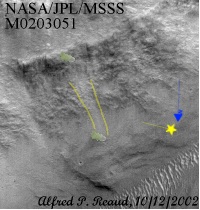 Figure 3
Figure 3 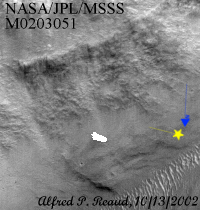 Figure 4
Figure 4 - In Figure 3, the nose cutouts at normal position and at the 'Crown'
are filled in with a gradient (RGB: 176, 229, 90, 30.5% opacity) for better
visibility. Transparent yellow indicates the path of the 'nose' from the
'Crown' to the 'nose position' on the 'King Face'.
- A GIF movie, Figure 4,
visually shows the proposed path of 'nose stone'.
Ground Slope On The 'King Face', Using The MOLA Data.
- The MOLA data archive used is
MGSL_21XX, from the
MOLA PDS Geosciences Node.
- Spacecraft time determining the actual PEDR data to use resides in
the PDS label in the IMQ file at M0203051. This time value equates
to a spacecraft time for the image as 614481377:145. Finding the correct
archive requires searching in the
MOLA index table (160KB) fields for the proper spacecraft time.
- Given this spacecraft time value, the correct archive to use is
ap11284l.b.
The preceding link takes you to the ap11xxx directory instead of the actual PEDR
file, which is 33.3MB long. Further processing
occurs on this binary data file, via
pedr2tab.exe software. Pedr2tab
creates a tabulated ASCII text file, which is usable with Microsoft Access
database software. Caution with computer resources should be noted here,
as the archive data set contains over 835,000 shots.
- The image boundaries, Mars coordinates, are 1.94° to
3.39° Latitude N, 275.45° to 275.59° Longitude W. Due to
coordinate origin differences, all MOLA data set coordinates use E longitudes.
Therefore, the correct Longitudes are 84.41°E to 84.55°E.
A query on the database imported into Microsoft Access provided 200 data
points for altimetry use.
- The spacing of these data points is 2.73·10-4 °/pixel
in longitude and 9.9370·10-5 °/pixel in latitude.
Use of a spreadsheet (Microsoft Excel) simplifies the computation of actual
pixels. See Figure 5,
an un-scaled section across approximately the whole image (511 pixels), from
vertical pixel 8393 to 8954 (561 pixels).
- The slope at (249, 8717), computed from the MOLA Data is approximately
-7.61%, -4.35°. A dollop of caution is necessary, as the assumption
is that the slope continues westwards from the MOLA track. Viewing
the image, Figure 5, one can
see that the MOLA track goes over what appears to be a 'pass' for lack of
better terms, on the 2nd through 4th shots from the
top. The 'pass' causes certain visual problems with the data points,
which may be resolved by shifting the dataset up by 1 data point. As
a 'pass' should be lower than the surrounding terrain, this better matches
the data itself, since the second shot from the top hit close to what could
be identified as the peak of a 'ridge'. The third shot from the top
then is at the approximate center of the 'pass' and is lower by 6.94 m (22.77
ft).
 Figure 5.
Figure 5. - The 4th shot hits what appears to be a field of fine debris
akin to sand that has been blown through the 'pass'. For the purposes
of argument, let us assume that the 4th shot is not present, and
we get the slope computed from the 2nd, 3rd, and 5th
shots from the top. This gives slopes of -2.34%, -1.34°
from the 2nd to the 3rd shot, and -2.85%, -1.63°
from the 3rd to the 5th shots. Cumulatively,
the slope from the 2nd to the 5thshot is -2.68%,
-1.54°, which is consistent to the previous comparison. The interpretation
of this is that the slope from the 2nd shot to the 5th
shot is consistent, and falls by 23.81 m (78.12 ft) over 888.2 m (2914 ft).
Therefore, the 4th shot is to be thrown out with respect to estimation
of the slope of the 'King Face ridge'.
Solar Azimuth and Shadow Length Giving Feature Height.
- Using the ancillary data provided on M0203051, one gets significant information
that is useful to interpret the image. Pertinent information is the
Scaled pixel width, Emission angle, Incidence angle, North azimuth, Sun azimuth, and Slant distance.
- The emission angle in conjunction with slant distance gives us a way
to determine how far off from vertical we are. For this image, our
emission angle is 0.21°. As an example, a 10m vertical wall would
have a visual span of approximately 3.7 cm, or 0.12 ft. This value,
being so much less than 1 pixel in this image, can safely be ignored.
As example, from orbital height, 384.58 km (238.97 mi) , the emission angle
causes a horizontal span of 1410 m (4625 ft) from vertical.
- The north azimuth likewise is immaterial in this section of the analysis,
as it will only be pertinent in sections dealing with the local wind.
Notice that the center latitude of this image, 2.66°, is very close
to equatorial.
- The incidence angle, along with the sun azimuth and scaled pixel width
allow rough trigonometric computations of feature heights, to within a pixel
resolution. This is accomplished by use of the formula: height
(m) = scaled pixel width (m/pixel)* shadow length (pixels) * tan(90°-
incidence angle°). The values should not be to more significant
figures than the least significant of the figures used, which is probably
the shadow length. In our image, the sun angle above the horizon is
50.58°. As example, a 10 m (32.8 ft) high object will cast a 8.2
m (27 ft) shadow at this sun elevation.
- With the above in mind, let us examine Figure 6, an un-normalized 5x cubic spline (GIMP)
scaling of the 'King Face' section of M0203051, using lowercase roman numerals
as designators:
- This feature is a dune field sectioned by a yellow
sun azimuth line. Observe at the point of the aqua line, that a dune
aligned with the sun azimuth line casts no shadow. Just to the right
of that point, a dune crosses the sun azimuth line at approximately90°,
and it casts a shadow approximately 1 pixel long in the original un-scaled
image. This indicates that the dune field is approximately7 m (23
ft) in height. Though not rigorously proven, it is assumed that the
length of the shadow depends on the sine of the angle the edge of the feature
makes with the sun azimuth, i.e. a dune parallel to the sun azimuth has an
angle of 0°, and hence sine( 0°) = 0. A dune perpendicular to
the sun azimuth has an angle of 90° to the sun azimuth, and therefore
sine( 90°) = 1. Research on this assertion will be the subject of
future revisions to this page.
- This is the right jaw of the 'King Face'. The 'right jaw' appears
inline to the sun azimuth and therefore no height information is available
from shadows. Therefore, the darkening exhibited here is not due to
shadows and must be some other form of discoloration such as dark material
or wetting.
- Going towards the upper left of the image, on the continuing 'right
jaw' line, this feature that starts out wide decreases to approximately one
pixel in width. Shadows indicate that where the sun azimuth line sections
this feature, it is approximately 7 m (23 ft) tall, there. This estimation
is uncertain though, as the original has minimal resolution in this area.
The 'jaw line' feature terminates in a 'knob'-like object at (iii-a).
The morphology almost appears to be that of a spring, with origin at (iii-a)
and termination at (iii-b), with a fingerlike pattern.
- To the upper right of (iii), we see the 'lips'. Here,
the terrain looks to slightly slope into a depression. No feature here
is significantly sharp to cast shadows, and any negative slope significantly
greater than the emission angle would not cast a shadow in any event.
Looking to the lower right, towards (i), we can see at least four
episodes of what looks to be fracturing with mass movement towards (i).
- Moving upwards of the 'lips' past the 'nose', we reach the 'eyes'.
The 'right eye' is at (v-a), the 'left eye' is at (v-b), and
a comparison crater is at (v-c). The morphology of (v-b)
and (v-c) is almost exact. (v-c) appears to have the
hint of a central feature, but it is not extremely obvious. (v-a)
is elliptical in nature. All three have the appearance of well worn
craters. There is also the possibility of a larger crater, centered
to the upper left of (v-a) which would define the whole 'right eye
socket'.
- Finally, upwards of the 'eyes' we reach the
'crown'. Here, we see an extension of the image features seen in Figure 5. The 'crown' continues
to the SW (upper right) in Figure 5, and forms part of the high points
of one of the visually aligned MOLA shots. Features of interest are
a half circle of unknown interpretation, (vi), partially obscured
by a height measurement. Other such features are a block fracture at
least 7 m (23 ft) high with sharp edges, (vi-a); a cleft or channel
separating the 'crown' from similar eastwards features, (vi-b); and
smaller crater features upwards of the 'right eye', (vi-c).
 Figure 6
Figure 6
- This feature is a dune field sectioned by a yellow
sun azimuth line. Observe at the point of the aqua line, that a dune
aligned with the sun azimuth line casts no shadow. Just to the right
of that point, a dune crosses the sun azimuth line at approximately90°,
and it casts a shadow approximately 1 pixel long in the original un-scaled
image. This indicates that the dune field is approximately7 m (23
ft) in height. Though not rigorously proven, it is assumed that the
length of the shadow depends on the sine of the angle the edge of the feature
makes with the sun azimuth, i.e. a dune parallel to the sun azimuth has an
angle of 0°, and hence sine( 0°) = 0. A dune perpendicular to
the sun azimuth has an angle of 90° to the sun azimuth, and therefore
sine( 90°) = 1. Research on this assertion will be the subject of
future revisions to this page.
Shape from Shading (Photoclinometry) Results.
- The page author has developed a plug-in for the GIMP imaging package
which generates shape from shading. Using shape from shading, Figure 6A shows the results viewed from
above and to the right. As can be seen, minimal elevation is apparent.
Compare the MOLA data image, Figure
5 with Figure 6A to see the striking
similarity of Figure 6A to the general
measurements of MOLA with respect to rendered dips and rises.
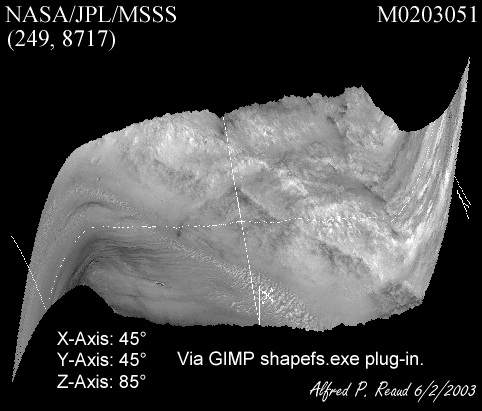 Figure 6A
Figure 6A
Look for new Shape From Shading movie here during the 2008 Holiday Season. - The author has also implemented a GIF Movie (807KB) of the above area at a more horizontal viewing angle, with the first frame in Figure 6B, rotated 360° in 10° increments. This also
shows minimal elevation rendering, highlighting the relative flatness of the area.
For comparison, see the examples at the shapefs download page for what rendered elevation should look like.
 Figure 6B (807KB).
Figure 6B (807KB).
Look for new Shape From Shading movie here during the 2008 Holiday Season.
- Another comparison can be done with Figure 6 and the argument in the Solar Azimuth and Shadow Length section. Figure 6A vindicates the arguments proposed
in that section. Please pay special attention to the dune features at i in Figure 6, the crater to the lower right of the 'King Face', the 'Crown'
ridge line, and the cleft area to the upper left of the 'King Face'.
- The curved areas at upper right and lower left of figures 6A
and 6B should be disregarded as artifacts
of the shape from shading algorithm, due to lack of boundary elevation values.
This is better observed with the GIF movie described above.
The Crown and Similar Nearby Features.
- Similar features to both east and west of the 'King Face' reproduce
the 'Crown' morphology. These features, on Figure 7, have the color aqua associated with them.
The 'King Face Crown' appears to sits on a ridge that proceeds in a curved
manner from SW to NE. This feature also appears to follow the valley
floor as indicated by the dune field. Also, see Figure 5.
- The dune field, indicated in the color purple, fills in areas of the
ridge, as indicated. This fill material, which is fine at the 5.78
m (19 ft) resolution of the image, also appears to start covering the dune
features. This investigator assumes sand, or similar fine material,
as it appears to be wind deposited from the cleft, described in section 4 e) vi), above. Similar
material is apparent under the sun azimuth indicator in Figure 7, and near the sun elevation
indicator in Figure 6, west
of the 'King Face right jaw'.
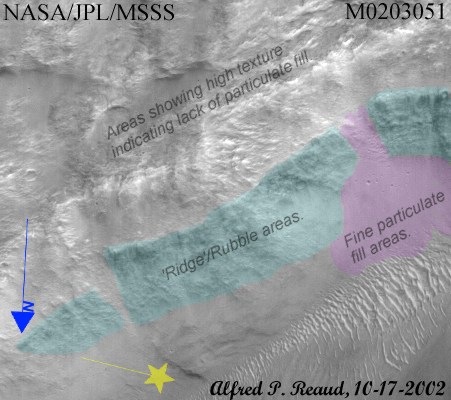 Figure 7
Figure 7
The Local Ambient Wind.
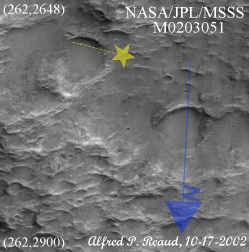 Figure 8
Figure 8
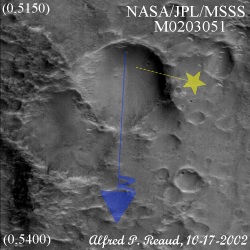 Figure 9
Figure 9- Finally, we examine the ambient wind. Figure 8 shows an
area where the wind direction is unambiguous, approximately 34.4 km (21.3
mi) S of the 'King Face'. Figure 9 shows another such area,
approximately 19.9 km (12.4 mi) to the S.
- In Figure 8, the ambient
wind has left a visible outflow on the crater under the N azimuth arrow (blue).
The interpretation of this signature is of a wind flow predominantly out
of the South. Further, the morphology of the terrain to the NE of this
crater is aligned normal to the southerly wind, generally.
- Figure 9 shows similar
morphology, with the flow indicia out of the crater closely aligned with
the N azimuth. Correlated morphology can be seen to the E of the large
crater.
- Similar areas of wind correlated morphology are visible throughout most
of M0203051, with such a large extent
that size constraints disallow introduction into this paper. These
areas are visible on the image at y coordinates 0-700, 2600-4700, (a plethora
of square craters at 4500-4900), and 13000-13400, approximately.
Conclusions:
- The 'King Face' has been described as evidence of artificiality on Mars
by certain researchers. To the author's knowledge, this feature on
Mars has not been subject to analysis as in this e-paper.
- The 'nose' appears to have slid or fallen to its current position.
It must be argued, for the total picture, that in comparison to a 1 pitch
(1”/12”, 8.33%, 4.76°) roof, the 'pitch' of this slope appears slight.
Though the computed approximate slope of the ridge this feature sits
on is inconclusive, examination of the image holistically enables one to
see that the wind has had a significant effect overall on large areas of
the image. A possibility exists that the salient features of the 'King Face'
have been pushed off the ridge by the prevailing wind.
- The 'eyes' appear to be crater features partially filled in by the material
coming off of the 'ridge' that is called by this author “undifferentiated
rubble”, due to its actual unknown origin. The 'lips' appear to be
soil fracturing and mass flow as can be seen on many terrestrial hillsides.
- The morphology of the 'Crown' and 'facial' area of that the 'King Face'
sits on appears to be a natural section of 'ridge' adjacent to a valley
or similar ground feature. As opposed to the Cydonia 'Face' which
is a separate feature not surrounded by similar terrain.
- Facial recognition appears hardwired in humans. This has been the subject
of a multitude of research and publication efforts, both in and out of science.
A short list of available sites on the internet relating to facial
recognition with a view towards the above argument:
Pareidolia.
The Most Deceitful Thing.
Philosophy Question 14-77. - The caveat of this research e-paper is that when examining space probe
images of extraterrestrial bodies, one should be extremely careful of verifying
the data. Humans are hardwired to see faces. Therefore,
over viewing the points covered here shows that the 'King Face' is a product
of fortuitously placed natural features that has the appearance of a face,
which human visual processing has a propensity to detect.
Alternate Conclusions and Rebuttals:
- As with all such endeavors, there is a difference of opinion as to the
interpretation of the feature in question. Since this author has requested
comment, numerous individuals have responded, pro and con, to the conclusions
presented here. Certain selected commentary is presented thusly:
- Peter Ness, MBA, MFin, MSc (Ba App Sc Ap Geol.), CDC, presents
the following commentary: Links where provided by the author of this
e-paper, and not by Mr. Ness. Therefore this author
takes full responsibility for the hyperlink accuracy's.
- I annotated the faults on this image of the 'King Face', Figure 10.
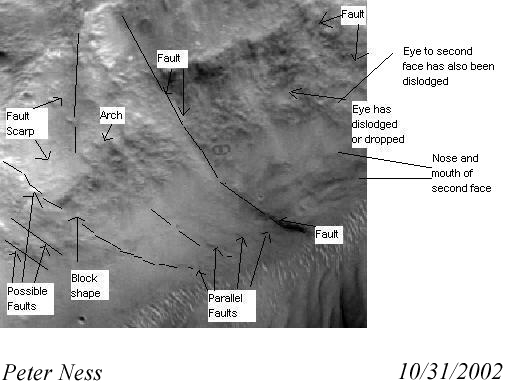 Figure 10
Figure 10
Note the second face merges with the first. If you have the 'Skull Face' image, the same thing happens. Page author's note: This image is located 70% down on the mapped jpeg and at (471,3704) on the IMG file. Grey scale equalization at minimum is required to bring it out. Two faces share an eye. One faces outwards and the other looks at an angle across the first. It is quite clever, because if you look from one direction one face should be seen and from another the second. In addition, in both cases, some people will only see one face - and will argue that the other does not exist - but the face they see will depend on whether the person is left or right brained or how their brain translates the images.
- The following things are rather interesting in relation to the 'King
Face':
- The faults coincide with and have displaced the arch down to the right.
- The right eye of the 'King Face' has dropped down. So has the
right eye of the right face. The nose of the second face has been cut
by a small fault. Move them back and the images are improved.
This is un-nerving from a geological perspective.
- The chin and left side of the 'King Face' is a normal fault. The
fault defines the shape of the face. The block that includes the entire
'King Face' has dropped down, partly obscuring the left side face, and gouging
it out. Interestingly the nose of the 'King Face' may coincide with
a vertical joint - there is no apparent vertical movement so is not a fault
(a least at this scale). Also the base of the mouths or chins of the
main 'King Face' and the one on its right faces have horizontal tear fracture
slippage planes so there is some mass wasting due to gravity sliding (unless
the faults are still active, which I doubt??).
- Some people see a third face truncated by the 'King Face'. The
large fault gouge on the left of the image (area is annotated - the smooth surface) shows that this
smaller face has been dislodged to the right - so if it really is a face -
the right eye and side of this face is caught up in the fault gouge of the
'King Face'.
- All the faults show rotational movement down to the right, except the
'King Face' which has just dropped down. If the reader looks at the
faults below the arch shape, they can see the rotation of the faults.
This shows the faults are slump structures related to normal faulting and
the faulting occurred after the supposed creation of 'King Face'. This
dates the 'King Face' and proves that the face is very old indeed- so was
formed before human civilization developed - so how the faces cannot be
human only humanoid in appearance.
- In each case when one moves the geology back to where it should be each
of the faces is enhanced - now to even the skeptic of skeptics that is rather
unusual (or unfortunate).
- The arch structure has three sides with an equithickness unit of rock,
which is a little hard to explain. This is probably a coincidence of
faulting, but it does not look natural.
- Above the 'King Face' there are some old 'spiders'
which formed in joints and fractures prior to the faulting. This dates
the rocks at the top of the cliff and may imply that the eyes of the faces
could have formed by degassing or from fluid expulsion at intersections of
joints and parallel bedding in the cliff. Joints form at regular intervals
so the vents would be paired. This is one feature of 'spiders'.
We often see face like pixilation in spider platforms. However, we
have not seen 'spiders' forming in vertical cliffs, only in caverns from old
vents. The problem may also be that of coincidence of rock type - a
particular rock type may be more likely to adopt a certain erosional or
weathering pattern. Thus, we may be more likely to see faces in a certain
rock type because of this. Moreover, this is precisely the argument
that most geologists will use to counter the argument of statistics (the
other problem with statistics is the type 2 error - concluding something
statistically based on an incorrect premise).
- The faults coincide with and have displaced the arch down to the right.
- I did not point out all the faults either - particularly to the right
side of the 'King Face'. In fact, there are other face like features
along the ridge further to the right of the 'King Face' and numerous small
faults and joint. There are at least a dozen or more in the image and
most are quite easy to spot. The very top left corner of the image
is another large fault block (the reader can see the fault plane in the top
of the cliff) - again the block slid to the right and down the hill with
a large amount of displacement.
- I would not find it odd if non-geologists were unable to pick the faults,
but it would be extremely unusual if geologists are unable to pick the majority
of the faults as they are extremely obvious.
- On earth, the 'King Face' area would be a highly frequented type geology
section, not because of the faces but because the fault relationships would
make it an invaluable place for training geologists in normal fault movement
principles. All these things may be tricks of the light due to geological
faults, a few 'spiders' or degassing vents in the cliff, and some weathering
but there are so many coincidences in the 'King Face' image that it is rather
unusual and very interesting to say the least (and I am a skeptic).
- None of this proves conclusively that the face is natural or artificial
- but is does say one thing - the age is very old. The face predated
the faulting because the eye has dropped due to the faulting. And
the face is located in a fault zone. Therefore - it is not human and
cannot possibly be human unless someone on earth creates a wormhole that
accidentally puts humans back in time and space on Mars - to the very time
when there was free flowing water in the river below.
- The Skull Face. The bottom face in the
'Skull Face' image - in this case the nose of the bottom face has slid down
the hill and again reversing the geological slump movement coincidentally
puts the nose back in the right location and the right shape - again this
should substantially improve the resolution of the image making the face
look more real (or more artificial). The other problem is that the
'Skull Face' image has a number of large images in a confined area and each
looks artificial. Interestingly the people who say the 'Skull Face'
is artificial only pointed out one of the faces. The probability of
more than one good quality hoax in the same image is certainly very low.
- Argument against statistics and probability - As with the 'King Face',
the rock types related to the 'Skull Face' will tend to weather in the same
way in local areas. The proof is rather simple - geologists look for
ore deposits based on geologic relationships. Gold mines are strung
out along faults and occur at fault jogs or intersections. Iron ore
mines are typically associated with folding and faulting - so geologists
use this to find the mine. Every mineral deposit on earth follows the
geologic relations - and it is a perfect statistical relationship. Therefore,
two faces in the 'Skull Face' area (I am told there are three or four faces)
can occur due to geology and this impacts dramatically on statistics.
- The rocks in both images are different but the age seems to roughly
correlate. In addition, both are in areas that may have had freely
flowing water and an era of thicker atmosphere at the time the images were
created - which may or may not be purely coincidental. However...it
is a rather interesting relationship to say the least.
- The 'King Face' and the 'Skull Face' both seem much older than the
Egyptian woman with the hat. This particular image is extremely easy
to explain by geology because the black spots are all fans and the lips
etc., can be explained as outwash fans.
- The biggest problem with the Egyptian woman (Nefertiti {approximately ½ down
the mapped jpeg, (292,4048) on the IMQ}) is that the age does not
match that of the other features. It is probably only a few tens of
thousands of years old at most (perhaps only several centuries at most),
because it is composed of features related to 'spiders' so has degassing
features and etching due to CO2 and water. The features in 'Nefertiti'
are identical to those we see in Southern Polar regions related to 'spider'
formation. For instance, the black markings like dots or small lines
are black fans. None has faded and the directional trends have not
been blown away or obscured by wind movement. In addition, the layering
in the hat can be explained as due to the layering of the bedding.
There are outflow and outwash features due to water below bursting and flooding
which some will say has have helped shape the object.
- The ages of the 'Skull' and 'King Face' probably match. There
is evidence for free water flow in the rivers and creeks nearby both.
The canyon of the 'King Face' still had water after the 'King Face' was
complete because the gravels cover the base of the neck (assuming there
was a neck). All three faces have evidence of past 'spider' activity
- which leads one to the conclusion that the geologic relationships are just
as strong for a natural cause as the evidence to the contrary.
- People can and will argue either side because beliefs and educational
background tend to cloud judgment - dramatically.
- All three features probably have a natural cause, but together they
are rather compelling. I did not discuss the 'Pyramid Face' of Mars
because that is even easier to explain away by geology. Yes, compelling
imagery but like the 'Nefertiti' face the geology is easy to explain (and
probably similar age).
- I am not sure if the reader has seen this Malin data of the face of Mars; the commentary gives
no real strong opinion, but Michael Malin's opinion is attached.
- I annotated the faults on this image of the 'King Face', Figure 10.
- Greg Orme, fellow Mars anomaly researcher rebuts the conclusions
of this e-paper as follows:
- The crown is indeed a ridge but it is cut on both sides to form the
crown. This indicates someone may well have used that natural feature
and altered it to fit. To complain it is a continuation of the cliff
is as silly as saying that it can't be a face because it is a continuation
of the ground. There appear to be two faces connected to each other,
both using one of the eyes. From that point of view then it could
not have the right jaw section as it wouldn't work with two faces.
Most people see the second face, Hoagland saw it, Art Bell saw it, both
without knowing about it before. The chances of two well defined faces
next to each other is very slight. Also there are many other faces
on the cliff each of which is probably good enough to rate a mention if
found elsewhere.
- The whole idea of a rock falling down to make the nose is absurd.
It isn't big enough to match any place where it supposedly fell off the
cliff, it must only be about 20 pixels in size at the most. The idea
that someone can match up 20 pixels definitively on part of a rubbled cliff
is simply impossible. Anyway it's a circular argument. To say
a rock fell off the cliff to where the nose is doesn't explain anything,
you might as well say a rock eroded into the right shape where it is.
Either it looks like a nose or it doesn't, and whether someone carved it
or moved a rock into place is another matter. There's not the slightest
bit of evidence from the photo to support a falling rock, it's just shifting
the burden of proof.
- Also the eyes look nothing like craters to me, and the crater pointed
out as a comparison is only a few dull pixels in size and doesn't look like
anything more than rubble to me. The eyes aren't the right shape for
a crater.
- The shadow information is all wrong too, there are plenty of dunes pointing
in the same direction as the jaw line and they cast shadows the same way.
- It all amounts to circular reasoning. Some people think it's
natural because they do, the reasons presented don't add up to anything at
all. On the other hand, no one, least of all knows whether it is artificial
or not. Both sides have a responsibility to check their facts a lot
more carefully than this.
- The lips come up clear enough in the shape from shading did to satisfy
me. The extension of the shape is consistent with weathering and collapse.
In fact, all the weathering on the face if you reversed its direction tends
towards a more face like shape not less.
- While it might not be interesting to you the King Face is the most
publicized feature on Mars next to Cydonia. When it was shown at the
press conference it created a worldwide sensation being on TV in the US,
Canada, and England. It was written up in the New York Post and was
featured on Good Morning America. FOX News did a half hour special
mainly on the King Face.
- While this doesn't prove much in itself it does indicate that hundreds
of millions of people around the world thought it looked enough like a face
to get all that publicity. So as far as I'm concerned the court of
public opinion thinks it looks a lot like a face, the arguments I've heard
against it are pretty dubious, and one day we'll find out if it is a face
or not.
- The crown is indeed a ridge but it is cut on both sides to form the
crown. This indicates someone may well have used that natural feature
and altered it to fit. To complain it is a continuation of the cliff
is as silly as saying that it can't be a face because it is a continuation
of the ground. There appear to be two faces connected to each other,
both using one of the eyes. From that point of view then it could
not have the right jaw section as it wouldn't work with two faces.
Most people see the second face, Hoagland saw it, Art Bell saw it, both
without knowing about it before. The chances of two well defined faces
next to each other is very slight. Also there are many other faces
on the cliff each of which is probably good enough to rate a mention if
found elsewhere.

